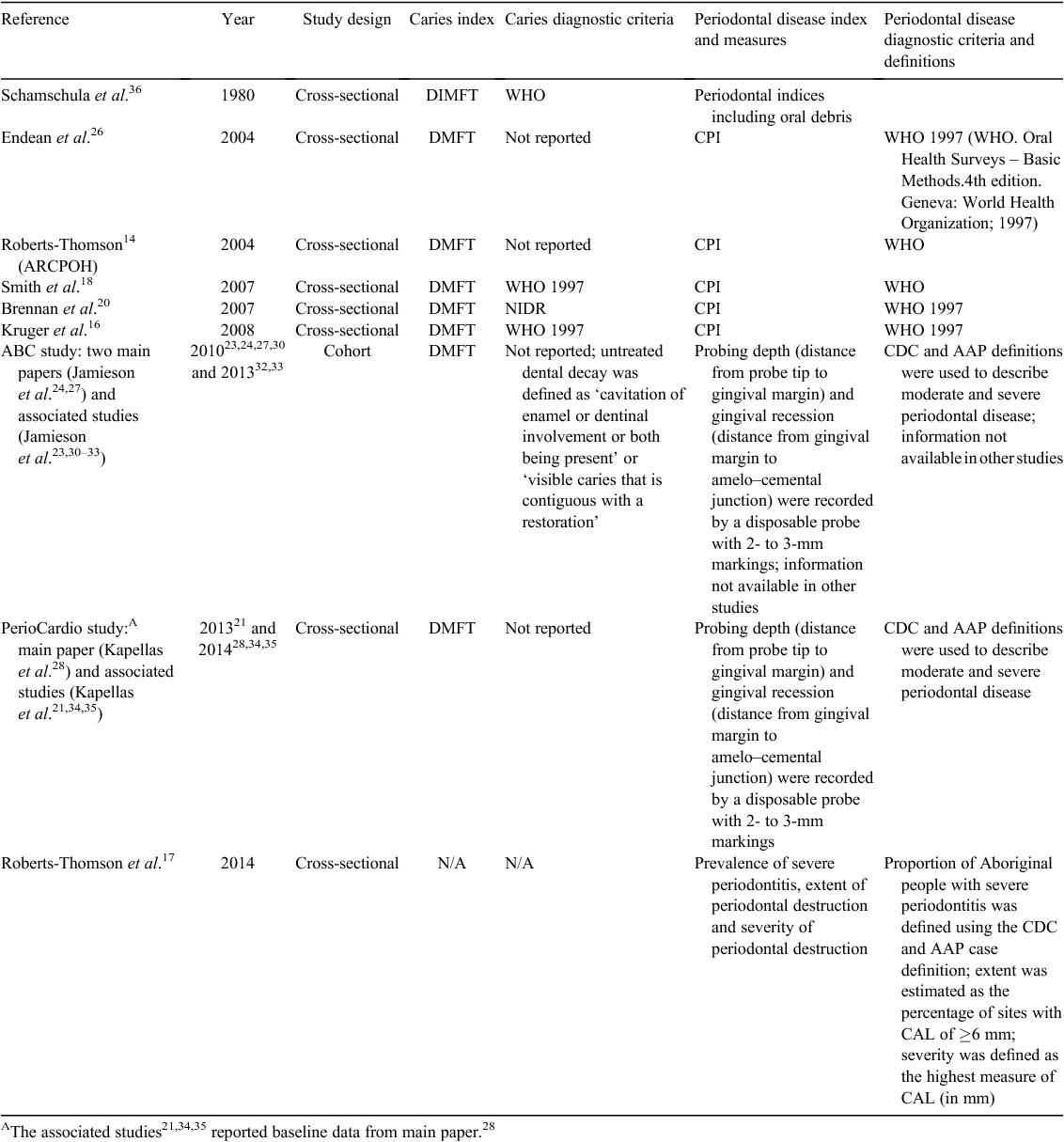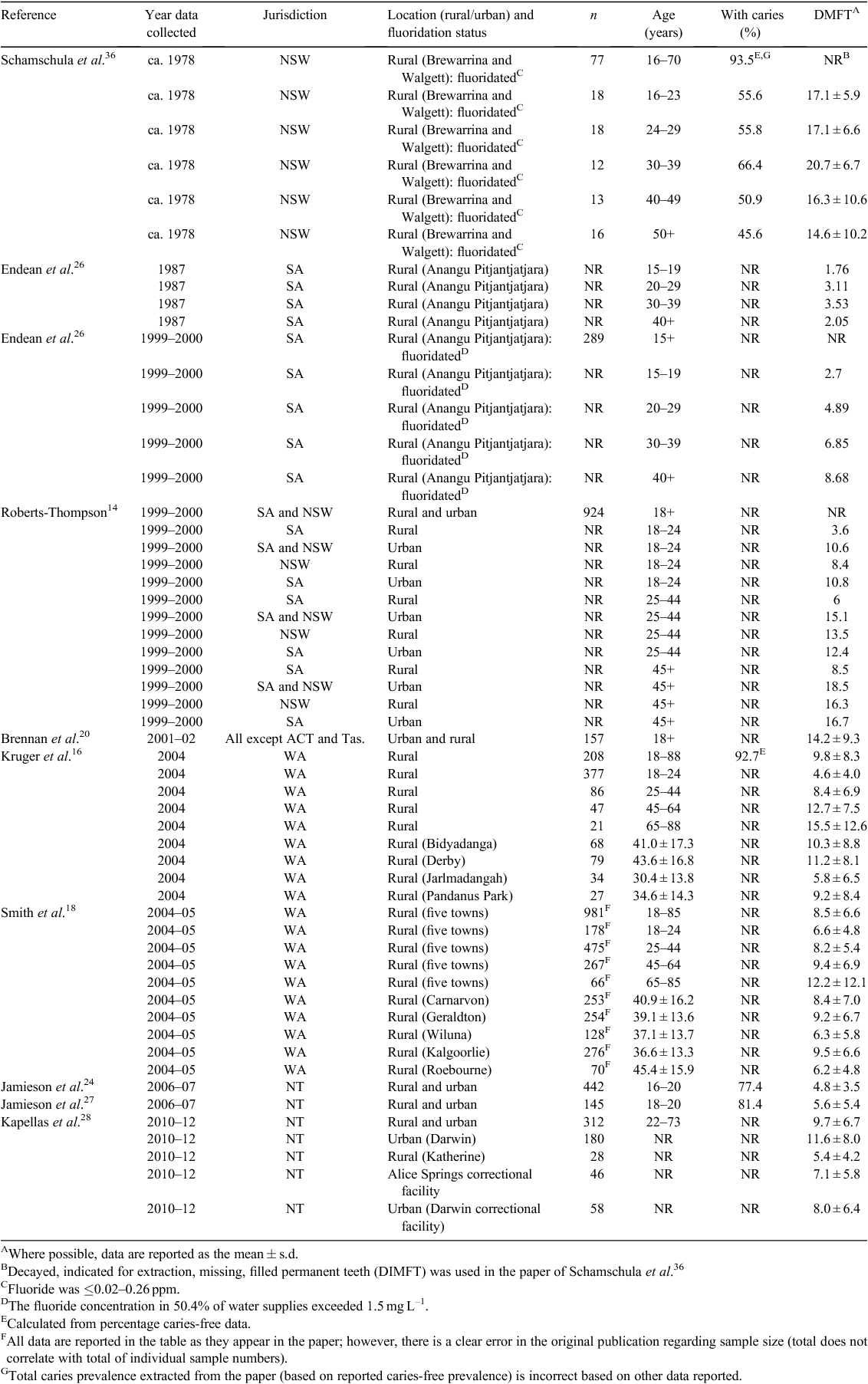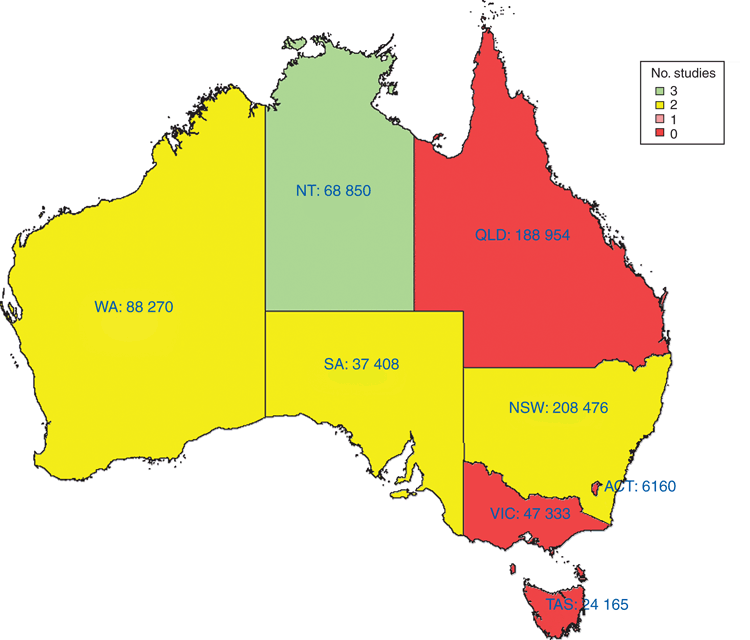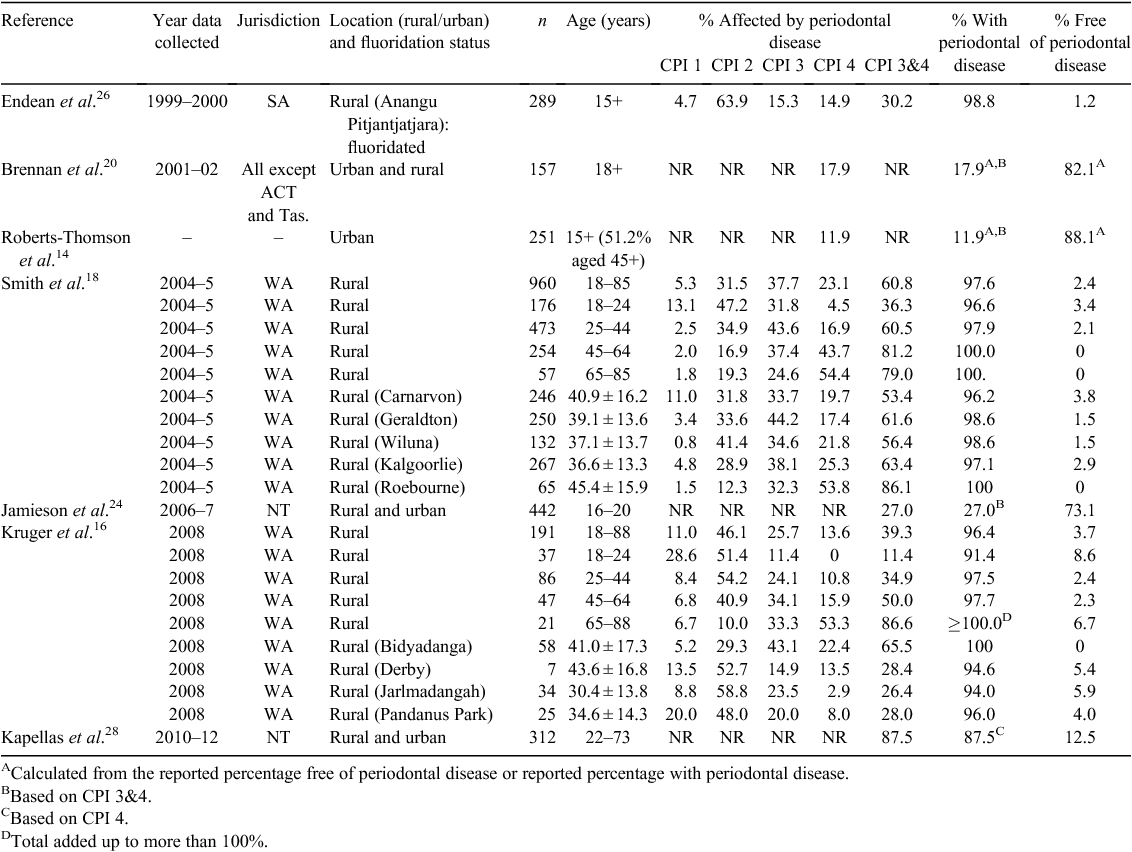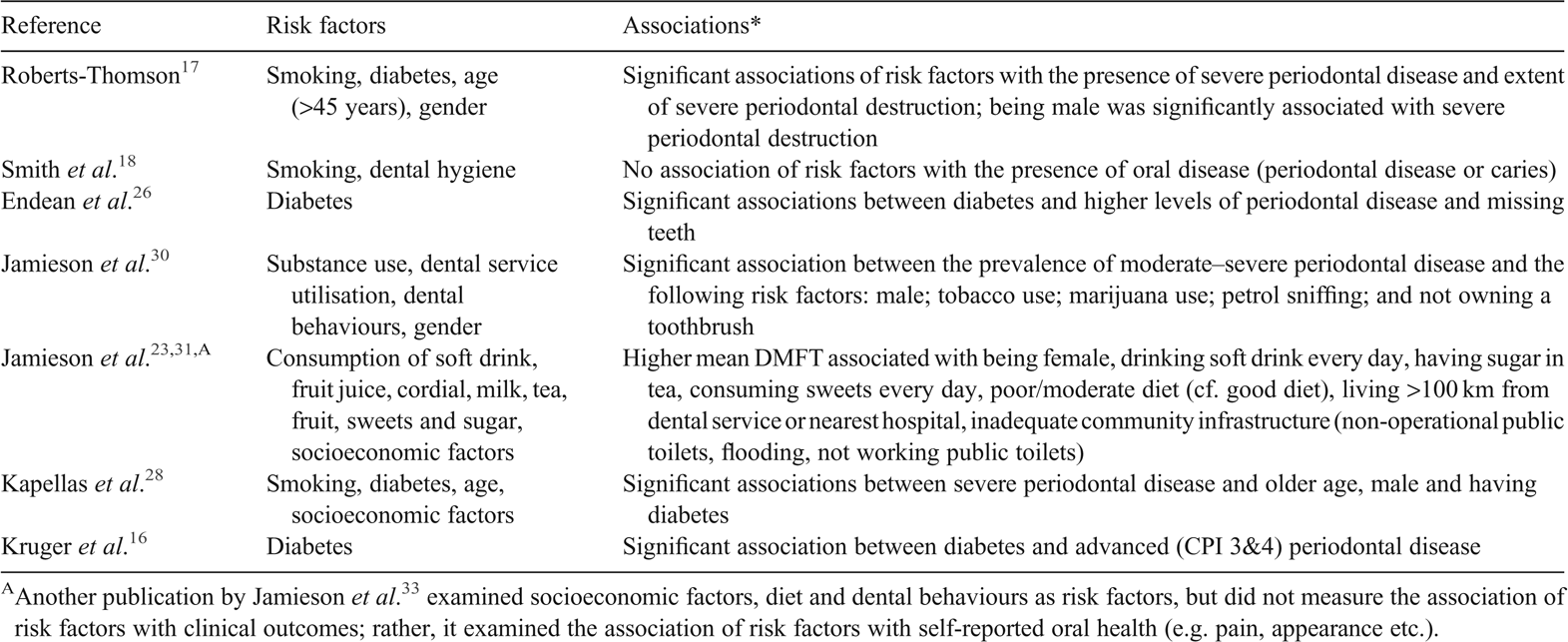Caries and periodontal disease in Indigenous adults in Australia: a case of limited and non-contemporary data
Andrea M. de Silva A B , Jacqueline M. Martin-Kerry C F , Katherine McKee D and Deborah Cole EA Institute for Safety, Compensation & Recovery Research, 222 Exhibition Street, Melbourne, Vic. 3000, Australia.
B Melbourne Dental School, The University of Melbourne, 720 Swanston Street, Carlton, Vic. 3053, Australia. Email: andreams@unimelb.edu.au
C Department of Health Sciences, University of York, Heslington, York, YO10 5DD, UK.
D Centre for Applied Oral Health Research, Dental Health Services Victoria, 720 Swanston Street, Carlton, Vic. 3053, Australia. Email: kmckee@deakin.edu.au
E Dental Health Services Victoria, 720 Swanston Street, Carlton, Vic. 3053, Australia. Email: deborah.cole@dhsv.org.au
F Corresponding author. Email: jackie.martin-kerry@york.ac.uk
Australian Health Review 41(4) 469-478 https://doi.org/10.1071/AH15229
Submitted: 9 December 2015 Accepted: 26 June 2016 Published: 29 August 2016
Journal Compilation © AHHA 2017 Open Access CC BY-NC-ND
Abstract
Objective The aim of the present study was to identify all evidence about the prevalence and severity of clinically measured caries and periodontal disease in Indigenous adults in Australia published in peer-reviewed journals and to summarise trends over time. In addition, we examined whether the studies investigated associations between putative risk factors and levels of caries and periodontal disease.
Methods PubMed was searched in September 2014, with no date limitations, for published peer-reviewed articles reporting the prevalence rates and/or severity of caries and periodontal disease in Indigenous adults living in Australia. Articles were excluded if measurement was not based on clinical assessment and if oral disease was reported only in a specific or targeted sample, and not the general population.
Results The search identified 18 papers (reporting on 10 primary studies) that met the inclusion criteria. The studies published clinical data about dental caries and/or periodontal disease in Australian Indigenous adults. The studies reported on oral health for Indigenous adults living in rural (40%), urban (10%) and both urban and rural (50%) locations. Included studies showed that virtually all Indigenous adults living in rural locations had periodontal disease. The data also showed caries prevalence ranged from 46% to 93%. Although 10 studies were identified, the peer-reviewed literature was extremely limited and no published studies were identified that provided statistics for a significant proportion of Australia (Victoria, Tasmania, Queensland or the Australian Capital Territory). There were also inconsistencies in how the data were reported between studies, making comparisons difficult.
Conclusions This review highlights a lack of robust and contemporary data to inform the development of policies and programs to address the disparities in oral health in Indigenous populations living in many parts of Australia.
What is known about the topic? Many studies report that Indigenous people in Australia have poorer general health compared with non-Indigenous people.
What does this paper add? This paper documents the available caries and periodontal disease prevalence and experience for Indigenous adults in Australia published in peer-reviewed journals. It demonstrates significant limitations in the data, including no data in several large Australian jurisdictions, inconsistency with reporting methods and most data available being for Indigenous adults living in rural locations. Therefore, the oral health data available in the peer-reviewed literature do not reflect the situation of all Indigenous people living in Australia.
What are the implications for practitioners? It is important for oral health practitioners to have access to current and relevant statistics on the oral health of Indigenous Australians. However, we have highlighted significant evidence gaps for this population group within the peer-reviewed literature and identified the limitations of the available data upon which decisions are currently being made. This paper also identifies ways to capture and report oral health data in the future to enable more meaningful comparisons and relevance for use in policy development.
Additional keywords: Aboriginal, decay, oral health, periodontitis, prevalence.
Introduction
Oral health is fundamental to both general health and quality of life1 and is influenced by a range of socioeconomic, environmental, behavioural, biological and cultural factors.2,3 Both dental caries (decay) and periodontal disease (gum disease) are largely preventable, and even reversible in the early stages,4,5 and the effects of poor oral health include cardiovascular disease and poorer general health.5–7 As it progresses, oral disease can result in debilitating pain, difficulty eating and speaking, embarrassment and other negative effects.8 Australia’s National Oral Health Plan 2015–20249 highlights Aboriginal and Torres Strait Islander (within this paper referred to as Indigenous) people as a priority population group for targeting improvements in oral health. A key action of the National Oral Health Plan is to provide culturally appropriate and accessible oral health services through partnerships between mainstream and Indigenous-specific oral health services. Until the late 20th century, the available data suggest that Indigenous Australians generally had better oral health than their non-Indigenous counterparts, with the main complaint being tooth wear.10,11 Dental caries and periodontal disease were uncommon at this time within Indigenous communities.10 Current research indicates that Indigenous people now experience considerably poorer general health12 and oral health13–19 than that of the non-Indigenous population. Although several reports suggest that Indigenous people suffer from more dental caries and periodontal disease than non-Indigenous people,13,19 there are very few studies that provide data on the oral health of Indigenous adults in Australia.15,20–22 These studies are often undertaken with small population groups, or remote communities, which are less generalisable to the current, broader Australian Indigenous population.20,23,24 Recent census data show that the Indigenous population of Australia makes up approximately 3% of the national population25 and is largely concentrated on the eastern coastline and clustered in cities.12
The aims of the present review were to identify all published evidence about the oral health in Indigenous adults in Australia, measured clinically, and summarise trends over time in order to provide a robust evidence base for the purposes of planning public dental service policy and program planning. The review also aimed to examine the data on the association between known risk factors and the prevalence of oral disease in this population group.
Methods
Search strategy and search terms
Clinical outcomes included in the search were caries (e.g. decayed, missing and filled permanent teeth (DMFT) and periodontal disease (e.g. community periodontal index (CPI). PubMed was searched independently by one author (JMM-K) and a research assistant (Alexandra Geale) to locate papers published before September 2014. The search terms were ‘Aboriginal’, ‘Indigenous’ and ‘Torres Strait Islander’, in association with ‘oral health’, ‘oral disease’, ‘rural and remote’, ‘models of care’, ‘primary care’, ‘dental caries’, ‘periodontal disease’, ‘DMFT’, ‘dental decay’, ‘oral disease prevention’, ‘fluoride’, ‘access to dental services’, ‘dental services’, ‘oral hygiene’, ‘oral health care’ and ‘oral health interventions’. Only journal articles were included in the present study; grey literature was not searched.
Inclusion and exclusion criteria
Abstracts were independently screened for inclusion by JMM-K and AG. To be included, the study must have reported the prevalence or severity of a clinical oral health outcome (caries or periodontal disease) in Australian Indigenous adults and data must have been collected during clinical examination (i.e. not self-reported dental experience or self-reported dental health). Papers were excluded from the study if the study sample was a targeted group (e.g. only individuals with oral disease selected from a disease registry) rather than the general population. Following the initial screening process, full-length articles were retrieved and the inclusion and exclusion criteria applied again.
Data extraction
Data extraction was undertaken for all papers by two authors (JMM-K and KM) independently. The data extracted from each paper included age of study sample, study design, year of study, year of data collection, the prevalence and severity of oral diseases, the clinical criteria used for measurement and diagnosis and all data reporting the relationship between measured risk factors and oral disease. Extracted data were entered into a Microsoft Excel spreadsheet and closely scrutinised to identify (and remove) duplication of data through different publications of the same study or sample. Prevalence and severity of both caries and periodontal disease were identified and tabulated as well as details of the population studied (age, location). Rural and urban location was extracted from papers where this was reported. Because of the variation in ages and reporting within the studies, no statistics were undertaken and no trend analysis was possible. Data are reported as presented within the papers included in the study.
Results
Search results
Figure 1 provides a summary of the results of the PubMed searches. The initial search identified studies of both children and adults. For the present review, only adult studies were included. When papers reported a broader range of ages, such as studies that grouped those aged 16–20 years, they are included here; studies of children aged <15 years were excluded. Eighteen papers were identified as meeting the criteria for caries and/or periodontal disease prevalence and/or severity in Indigenous adults. A summary of these papers is provided in Table 1. Of the 18 papers, 10 were primary studies14,16–18,20,24,26–28,36 and eight were associated papers, reporting the same data in a different way21,23,30–35 (Table 1).
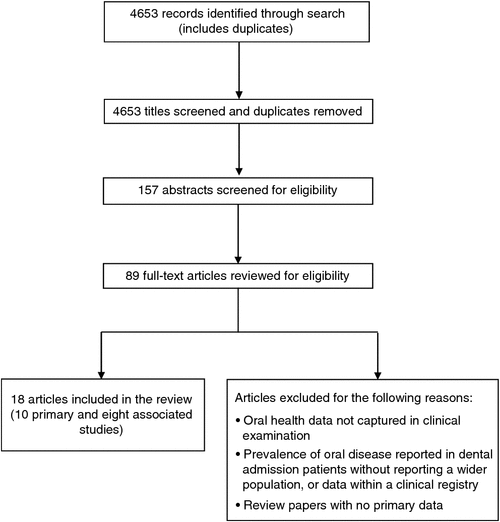
|
Study characteristics
Table 2 presents temporal and geographical information about the studies included in the review. In most (seven) studies,16,18,24,26,27,28,36 data were collected in only one jurisdiction. One study collected data from two jurisdictions,14 one study collected data from all jurisdictions except the Australian Capital Territory and Tasmania20 and one study17 did not report the location from where the data were collected. Across these jurisdictions, four studies16,18,26,36 (40%) reported on Indigenous adults living only in rural locations, five studies14,20,24,27,28 reported on Indigenous adults living in both urban and rural locations (with most reporting data for the total population in the sample rather than reporting the data by urban or rural location) and one study reported only on an urban sample.17 Figure 2 summarises the number of studies publishing data for each jurisdiction, with total Indigenous population numbers. Only two studies26,36 (20%) reported the fluoride status of the study’s location. Data were presented using a variety of age groupings, which makes comparisons between studies difficult.
Caries prevalence and severity
As can be seen from Table 1, the diagnostic criteria and manner in which clinical data were reported varied across the studies. The earliest study36 reported caries using the decayed, indicated for extraction, missing or filled permanent teeth (DIMFT) index. All other studies investigating caries used the DMFT index, but many did not report which specific World Health Organization (WHO) criterion37 was used. All studies that examined caries (nine primary studies) reported mean DMFT (or DIMFT). Caries data as reported in the papers are summarised in Table 2. Only four papers reported caries prevalence data.16,24,27,36 Caries prevalence ranged from 46% to 93% of Indigenous adults experiencing caries. Mean DMFT also varied considerably across the studies. Two studies14,20 also included a non-Indigenous sample as a comparison group.
Periodontal disease prevalence and severity
Periodontal disease data from the included studies are presented in Table 3. Eight primary studies (80%) reported levels or prevalence of periodontal disease. Periodontal disease was primarily measured using the CPI score of between 0 and 4, with 0 being normal/healthy gums, 1 being bleeding, 2 being calculus present, 3 being moderate periodontal disease and 4 being severe periodontal disease. Often data were reported with CPI levels collapsed into fewer groups. Three studies reported data only at the level of moderate and/or severe periodontal disease, whereas three studies reported data across all CPI scores. The level of periodontal disease identified in the study samples varied. Three studies reported periodontal disease ranging from 12% to 27%,17,20,24 although these studies only reported periodontal disease at the more severe levels (CPI 3 and/or 4). Four studies16,18,26,28 reported the prevalence of periodontal disease to be above 85%; three of these studies included all four CPI scores, which may explain the high reported prevalence (one of the studies reporting high periodontal disease prevalence only reported CPI 3 and 4).
Association between risk factors and prevalence of oral disease
Eight16,17,18,23,24,28,30,33 of the 18 papers reported associations between the presence of known risk factors and the prevalence of caries or periodontal disease (see Table 4). High dietary sugar content was significantly associated with dental caries in two papers23,33 and diabetes was significantly associated with a higher prevalence of moderate or severe periodontal disease in three papers.16,26,28 One study examined the relationship between abuse of various substances (e.g. marijuana and petrol sniffing) and oral disease and identified that a higher prevalence of periodontal disease was associated with these risk factors.30 Two studies identified associations between the prevalence of severe periodontal disease and being male, and aged over 45 years.16,17 Tobacco smoking is considered an established risk factor for periodontal disease and two studies examined this relationship: one study reported a positive association with periodontal disease prevalence,28 but the other study did not.18
Discussion
The present review is the first to summarise oral disease data for Indigenous adults living in Australia, documenting the clinically measured dental caries and periodontal disease data for Indigenous adults published in the peer-reviewed literature until September 2014. We endeavoured to identify the best available research evidence throughout Australia, to underpin the development of new services, policies and programs to both increase access to the public oral healthcare system for Indigenous people and to ensure that we are delivering the right strategies to meet the needs of this priority population group.
The study identified limited data for clinically measured caries and periodontal disease in Indigenous adults. The findings highlight that because of inconsistencies in how the data were collected and reported, conclusions about the level of oral health in Indigenous adults are difficult to make. However, periodontal disease and caries levels are high, particularly in rural locations, where most of the studies in the present review were undertaken. Most studies did not report the fluoride status for the study location; therefore, it was not possible for us to examine the relationship between water fluoride levels and levels of caries in this study.
Approximately 700 000 Indigenous people live in Australia, with almost 80% living in major cities and regional areas. Despite this, almost all studies identified in this review reported oral health data for Indigenous adults living in rural locations. Furthermore, a recent report12 projects that 67% of the Indigenous population in Australia live in the eastern jurisdictions, but there were only two studies,14,36 that included New South Wales and no studies in the other jurisdictions. This is an evidence gap that could be addressed by better utilisation and publication of public oral health data that are already routinely collected by each jurisdiction. In Victoria, for example, 1125 Indigenous adults attended the Royal Dental Hospital Melbourne over a 2-year period (Martin-Kerry JM, de Silva AM, Tennant M, Bacchia P, Cole D, unpublished DHSV data). This is administrative clinical data routinely collected at the Dental Hospital. We are aware that in 2014–15 public oral health care was provided across Victoria to more than 8500 Indigenous adults; however, these data are not publicly available within the peer-reviewed literature. We do acknowledge that oral health data are available in the grey literature.
Undertaking data collection for the oral health of specific population groups is met with difficulties, such as associated costs and time requirements, as well as difficulties achieving a representative sample. The present review identified inconsistencies in data capture and reporting, limiting the ability for meaningful comparisons and analysis. There was inconsistency in the way that the data were presented, including various age groupings used, which made it difficult for comparisons to be made across studies. Despite some studies looking at the oral health of Indigenous adults living in rural and urban locations, the data were not separated by location, making it difficult to determine whether living in a rural location affected oral health status of Indigenous adults in the study. We found that the usefulness of the available scientific data for decision makers is extremely limited and is not contextually relevant in many cases.
A similar review was recently undertaken to identify oral health data for Indigenous children published in peer-reviewed literature, and that study identified significant gaps in the available published research data.38 The present review has identified that the data available for the oral health of Indigenous adults living throughout Australia are more limited than those available for Indigenous children. This is despite approximately one-third of Indigenous people attending the public oral healthcare system.39 We are aware that administrative and clinical data are collected in many jurisdictions and that this could be better utilised and published in the peer-reviewed literature to make it more readily available.
Caries
All studies that examined caries presented this using mean DMFT, but standard deviation was often not reported. Mean DMFT reported in the included studies ranged considerably from 1.8 (in young adults in 1987)26 through to 20.7,36 with mean DMFT generally being higher in the older age groups. The caries data presented herein represents a total sample size of 3390 Indigenous adults living in Australia. We are aware of one paper40 that reported caries in Indigenous people that was not identified through the search terms used in the present study because it examined overall caries levels in adults in Australia, and did not use ‘Indigenous’ or ‘Aboriginal’ as a key term or as a focus of the paper. That paper reported national data from the National Survey of Adult Oral Health (NSAOH; 2004–06) for all adults (mean DMFT 12.8), with Indigenous people being one sub-sample (mean DMFT 14.8).40 The NSAOH data suggests that caries levels in the general adult community are high and, in some instances, are similar to caries levels in Indigenous adults identified herein. Overall caries prevalence data were only reported in a small number of studies.
Periodontal disease
The periodontal disease prevalence and severity data presented herein represent a total sample size of 2602 Indigenous adults living in Australia. The proportion of Indigenous adults affected by periodontal disease within the studies reviewed herein was extremely high. Prevalence was virtually 100% in all rural locations, which was the vast majority. Interestingly, the few studies that included urban samples had a lower prevalence of periodontal disease. We have identified one paper41 that reported periodontal disease in Indigenous people that was not found through the search terms used in the present review because it focused on overall adult periodontal disease and did not focus on periodontal disease in Indigenous people. The paper also did not use the term ‘Indigenous’ or ‘Aboriginal’ as a key search term nor did it refer to ‘Aboriginal’ or ‘Indigenous’ in the Abstract. That paper reported data from the NSAOH 2004–06 and indicated that 22.9% of the general adult population and 29% of Indigenous adults within the survey had moderate to severe periodontal disease. This difference in periodontal disease prevalence compared with the prevalence reported herein may reflect the difference in reporting with regard to disease severity, as well as the population groups and geographic locations included in the studies.
Risk factors for oral disease
It was of interest to identify studies that examined the links between risk factors and caries or periodontal disease and interventions designed to improve the levels of these conditions. Previous research has identified a relationship between periodontal disease and other systemic conditions, including diabetes and cardiovascular disease.42,43 The association between diabetes and periodontal disease reported in several of the papers reviewed herein relates to the possible bidirectional relationship between diabetes and periodontal disease.42 However, a recent systematic review has suggested that there is limited evidence that periodontal treatment can produce sustainable decreases in blood glucose.44 Given the findings of that systematic review, more research into the specific risk factors and pathogenesis of periodontal disease in Indigenous adults is critical in order to develop and implement preventive strategies and to promote early identification and treatment of the disease. The present review also identified one intervention trial examining the effect of periodontal therapy for Indigenous Australians and whether this affects arterial structure and function, because inflammation (which is present in periodontal disease) is a key factor in the development of vascular disease such as atherosclerosis.34 However, there was a lack of studies that addressed risk factors as a way of improving oral health levels in Indigenous adults, with most studies simply describing the level of oral disease in this population and a small number describing associations between risk factors and oral disease. It would be beneficial to design studies that attempt to address a known risk factor for the development of oral disease.
Strengths and limitations
The present study highlights the available data on clinically measured caries and periodontal disease in Indigenous adults published in the peer-reviewed literature. We chose to search only peer-reviewed literature to identify the best quality evidence available, and were surprised that such a limited number of articles was identified that provided clinically measured caries and periodontal disease data for Indigenous adults throughout Australia. The present study identifies a lack of data for this priority population group. A limitation of the present study is that it does not include grey literature. We acknowledge that evidence is available within the grey literature, but the aim of the present study was to explore what was available and accessible specific to Indigenous oral health in the research and evidence base.
Conclusions and recommendations
The present review highlights that despite Indigenous people being a priority group for the public oral healthcare system, the available data have significant limitations. Because of small numbers, variations in data capture and reporting and the different age groups studied, further analyses of the data reported were not possible. However, the learnings from the present study have led us to make the following recommendations:
-
The use of a consistent approach in the reporting of oral health data in Indigenous adults with regard to age groupings and prevalence statistics, as well as identification of classification of geographic location as rural or urban etc.
-
Performing research that goes beyond simply describing oral disease and undertakes more sophisticated exploration of risk and protective factors to inform the development of solutions
-
Better utilisation, and publication in peer-reviewed journals, of routinely collected public oral health data for Indigenous adults, particularly in metropolitan and regional areas of Australia, such as Victoria, New South Wales and Queensland, and the regular publication of prevalence statistics.
Competing interests
The authors declare no competing interests.
Acknowledgements
The authors thank Dr Bradley Christian and Ms Michelle Leembruggen for undertaking some of the data extraction, Ms Holly Brown for editing the final manuscript, Ms Alexandra Geale for undertaking the literature search and initial review of abstracts and Dr Martin Whelan for producing the map (Fig. 2).
References
[1] National Advisory Committee on Oral Health. Healthy mouths healthy lives: Australia’s National Oral Health Plan 2004–2013. Adelaide: South Australian Department of Health; 2004.[2] Vanobbergen J, De Visschere L, Daems M, Ceuppens A, Van Emelen J. Sociodemographic determinants for oral health risk profiles. Int J Dent 2010; 2010 938936
| Sociodemographic determinants for oral health risk profiles.Crossref | GoogleScholarGoogle Scholar | 1:STN:280:DC%2BC3c3hsVamuw%3D%3D&md5=c728c6df67cf3b17d43c202ffa06f693CAS | 20339491PubMed |
[3] Watt RG, Sheiham A. Integrating the common risk factor approach into a social determinants framework. Community Dent Oral Epidemiol 2012; 40 289–96.
| Integrating the common risk factor approach into a social determinants framework.Crossref | GoogleScholarGoogle Scholar | 22429083PubMed |
[4] Gomes MS, Chagas P, Padilha DMP, Caramori P, Hugo FN, Schwanke CHA, Hilgert JB. Association between self-reported oral health, tooth loss and atherosclerotic burden. Braz Oral Res 2012; 26 436–42.
| Association between self-reported oral health, tooth loss and atherosclerotic burden.Crossref | GoogleScholarGoogle Scholar | 22892878PubMed |
[5] Otomo-Corgel J, Pucher JJ, Rethman MP, Reynolds MA. State of the science: chronic periodontitis and systemic health. J Evid Based Dent Pract 2012; 12 20–8.
| State of the science: chronic periodontitis and systemic health.Crossref | GoogleScholarGoogle Scholar | 23040337PubMed |
[6] Pinho MM, Faria-Almeida R, Azevedo E, Conceição Manso M, Martins L. Periodontitis and atherosclerosis: an observational study. J Periodontal Res 2013; 48 452–7.
| Periodontitis and atherosclerosis: an observational study.Crossref | GoogleScholarGoogle Scholar | 23278448PubMed |
[7] Ramirez JH, Parra B, Gutierrez S, Arce RM, Jaramillo A, Ariza Y, Contreras A. Biomarkers of cardiovascular disease are increased in untreated chronic periodontitis: a case control study. Aust Dent J 2014; 59 29–36.
| Biomarkers of cardiovascular disease are increased in untreated chronic periodontitis: a case control study.Crossref | GoogleScholarGoogle Scholar | 1:STN:280:DC%2BC2cvhvFOgtQ%3D%3D&md5=823d9b5f83033e0aba33d2d95c73fe35CAS | 24495202PubMed |
[8] UK Department of Health. An oral health strategy for England. London: HMSO Publications; 1994.
[9] Oral Health Monitoring Group. Australia’s National Oral Health Plan 2015–2024, healthy mouths healthy lives. Adelaide: South Australian Dental Service; 2015.
[10] Campbell TDGJ. Observations on the teeth of Australian Aborigines. Aust Dent J 1936; 40 290–5.
[11] Harford JSJ, Roberts-Thomson K. Oral health. In Thomson N, editor. The health of Indigenous Australians. Melbourne: Oxford University Press; 2003. pp. 313–38.
[12] Australian Institute of Health and Welfare (AIHW). The health and welfare of Australia’s Aboriginal and Torres Strait Islander people 2015. Canberra: AIHW; 2015.
[13] Slade GDSA, Roberts-Thomson KF, editors. Australia’s dental generations: the National Survey of Adult Oral Health 2004–06. Catalogue no. DEN 165. Canberra: Australian Institute of Health and Welfare; 2007.
[14] Roberts-Thomson K, Australian Research Centre for Population Oral Health Oral health of Aboriginal Australians. Aust Dent J 2004; 49 151–3.
| Oral health of Aboriginal Australians.Crossref | GoogleScholarGoogle Scholar | 15497360PubMed |
[15] Amarasena N, Kapellas K, Skilton MR, Maple-Brown LJ, Brown A, O’Dea K, Celermajer D, Jamieson L. Associations with dental caries experience among a convenience sample of Aboriginal Australian adults. Aust Dent J 2014; 75 126–33.
[16] Kruger E, Smith K, Atkinson D, Tennant M. The oral health status and treatment needs of Indigenous adults in the Kimberley region of Western Australia. Aust J Rural Health 2008; 16 283–9.
| The oral health status and treatment needs of Indigenous adults in the Kimberley region of Western Australia.Crossref | GoogleScholarGoogle Scholar | 18808486PubMed |
[17] Roberts-Thomson KF, Do LG, Bartold PM, Daniels J, Grosse A, Meihubers S. Prevalence, extent and severity of severe periodontal destruction in an urban Aboriginal and Torres Strait Islander population. Aust Dent J 2014; 59 43-7
| Prevalence, extent and severity of severe periodontal destruction in an urban Aboriginal and Torres Strait Islander population.Crossref | GoogleScholarGoogle Scholar | 24502510PubMed |
[18] Smith K, Kruger E, Dyson K, Tennant M. Oral health in rural and remote Western Australian Indigenous communities: a two-year retrospective analysis of 999 people. Int Dent J 2007; 57 93–9.
| Oral health in rural and remote Western Australian Indigenous communities: a two-year retrospective analysis of 999 people.Crossref | GoogleScholarGoogle Scholar | 1:STN:280:DC%2BD2s3psFyqsA%3D%3D&md5=08ffb4c2de4a73c74f2c768562e95909CAS | 17506468PubMed |
[19] Durey A, Bessarab D, Slack-Smith L. The mouth as a site of structural inequalities; the experience of Aboriginal Australians. Community Dent Health 2016; 33 161–3.
| 1:STN:280:DC%2BC2s7kvValug%3D%3D&md5=a0efc79689384dfbac3a9db2132e1746CAS | 27352474PubMed |
[20] Brennan DS, Roberts-Thomson KF, Spencer AJ. Oral health of Indigenous adult public dental patients in Australia. Aust Dent J 2007; 52 322–8.
| Oral health of Indigenous adult public dental patients in Australia.Crossref | GoogleScholarGoogle Scholar | 1:STN:280:DC%2BD1c7gvVahsA%3D%3D&md5=d07814c608a4f44dbcdea8f5cdadbe26CAS | 18265689PubMed |
[21] Kapellas K, Do LG, Mark Bartold P, Skilton MR, Maple-Brown LJ, O’Dea K, Brown A, Celermajer DS. Effects of full-mouth scaling on the periodontal health of Indigenous Australians: a randomized controlled trial. J Clin Periodontol 2013; 40 1016–24.
| Effects of full-mouth scaling on the periodontal health of Indigenous Australians: a randomized controlled trial.Crossref | GoogleScholarGoogle Scholar | 23992525PubMed |
[22] Williams S, Jamieson LM, MacRae A, Gray C. Review of Indigenous oral health. Australian Indigenous Health Info Net; 2011. Available at: http://www.healthinfonet.ecu.edu.au/other-health-conditions/oral/reviews/our-review [verified 10 June 2015].
[23] Jamieson LM, Roberts-Thomson KF, Sayers SM. Dental caries risk indicators among Australian Aboriginal young adults. Community Dent Oral Epidemiol 2010; 38 213–21.
| Dental caries risk indicators among Australian Aboriginal young adults.Crossref | GoogleScholarGoogle Scholar | 20059488PubMed |
[24] Jamieson LM, Sayers SM, Roberts-Thomson KF. Clinical oral health outcomes in young Australian Aboriginal adults compared with national-level counterparts. Med J Aust 2010; 192 561
[25] Australian Bureau of Statistics. Estimates of Aboriginal and Torres Strait Islander Australians, June 2011. 2011. Available at: http://www.abs.gov.au/ausstats/abs@.nsf/mf/3238.0.55.001 [verified 12 June 2015].
[26] Endean C, Roberts-Thomson K, Wooley S. Anangu oral health: the status of the Indigenous population of the Anangu Pitjantjatjara lands. Aust J Rural Health 2004; 12 99–103.
| Anangu oral health: the status of the Indigenous population of the Anangu Pitjantjatjara lands.Crossref | GoogleScholarGoogle Scholar | 15200519PubMed |
[27] Jamieson LM, Armfield JM, Roberts-Thomson KF, Sayers SM. A retrospective longitudinal study of caries development in an Australian Aboriginal birth cohort. Caries Res 2010; 44 415–20.
| A retrospective longitudinal study of caries development in an Australian Aboriginal birth cohort.Crossref | GoogleScholarGoogle Scholar | 1:STN:280:DC%2BC3cjpsFSrsg%3D%3D&md5=58b2433c6164694d10da29d7d0eaeebaCAS | 20720421PubMed |
[28] Kapellas K, Skilton M, Maple-Brown L, Do L, Bartold P, O’Dea K, Brown A, Celermajer DS, Slade GD, Jamieson LM. Periodontal disease and dental caries among Indigenous Australians living in the Northern Territory, Australia. Aust Dent J 2014; 59 93–9.
| Periodontal disease and dental caries among Indigenous Australians living in the Northern Territory, Australia.Crossref | GoogleScholarGoogle Scholar | 1:STN:280:DC%2BC2cvhvFKqsg%3D%3D&md5=c24ac1589cfcaecf9d5ac7b440a001bfCAS | 24495146PubMed |
[29] Schamschula RG, Cooper MH, Wright MC, Agus HM, Un PS. Oral health of adolescent and adult Australian aborigines. Community Dent Oral Epidemiol 1980; 8 370–4.
| Oral health of adolescent and adult Australian aborigines.Crossref | GoogleScholarGoogle Scholar | 1:STN:280:DyaL3M7js1yhtA%3D%3D&md5=4ad6c42600693cb49db3953dea9208baCAS | 6937284PubMed |
[30] Jamieson LM, Gunthorpe W, Cairney SJ, Sayers SM, Roberts-Thomson KF, Slade GD. Substance use and periodontal disease among Australian Aboriginal young adults. Addiction 2010; 105 719–26.
| Substance use and periodontal disease among Australian Aboriginal young adults.Crossref | GoogleScholarGoogle Scholar | 20148786PubMed |
[31] Jamieson LM, Roberts-Thomson KF, Sayers SM. Risk indicators for severe impaired oral health among Indigenous Australian young adults. BMC Oral Health 2010; 10 1
| 20102640PubMed |
[32] Jamieson LM, Sayers SM, Roberts-Thomson KF. Associations between oral health and height in an Indigenous Australian birth cohort. Community Dent Health 2013; 30 58–64.
| 1:STN:280:DC%2BC3sritVCntQ%3D%3D&md5=bda5abf2e249863e48c89c51292a5e57CAS | 23550509PubMed |
[33] Jamieson LMD, Bailie RS, Sayers SM, Turrell G. Associations between area-level disadvantage and DMFT among a birth cohort of Indigenous Australians. Aust Dent J 2013; 58 75–81.
| Associations between area-level disadvantage and DMFT among a birth cohort of Indigenous Australians.Crossref | GoogleScholarGoogle Scholar | 1:STN:280:DC%2BC3svhs1Kgug%3D%3D&md5=367a58f8903d880f3dcb010e0612f93fCAS |
[34] Kapellas K, Jamieson LM, Do LG, Bartold PM, Wang H, Maple-Brown LJ, O’Dea K, Brown A, Celermajer DS, Slade GD, Skilton MR. Associations between periodontal disease and cardiovascular surrogate measures among Indigenous Australians. Int J Cardiol 2014; 173 190–6.
| Associations between periodontal disease and cardiovascular surrogate measures among Indigenous Australians.Crossref | GoogleScholarGoogle Scholar | 24613366PubMed |
[35] Kapellas K, Maple-Brown LJ, Jamieson LM, Do LG, O’Dea K, Brown A, Cai TY, Anstey NM, Sullivan DR, Wang H, Celermajer DS, Slade GD, Skilton MR. Effect of periodontal therapy on arterial structure and function among Aboriginal Australians. Hypertension 2014; 64 702–8.
| Effect of periodontal therapy on arterial structure and function among Aboriginal Australians.Crossref | GoogleScholarGoogle Scholar | 1:CAS:528:DC%2BC2cXhsFWhurnO&md5=b804747ffe82cf0c79309cc5d5f826baCAS | 24958498PubMed |
[36] Schamschula RG, Cooper MH, Adkins BL, Barmes DE, Agus HM. Oral conditions in Australian children of Aboriginal and Caucasian descent. Community Dent Oral Epidemiol 1980; 8 365-9
| Oral conditions in Australian children of Aboriginal and Caucasian descent.Crossref | GoogleScholarGoogle Scholar | 6937283PubMed |
[37] World Health Organization. Oral health surveys – basic methods, 5th edn. Geneva: WHO; 2012.
[38] de Silva AM, Martin-Kerry JM, Geale A, Cole D. Flying blind: trying to find solutions to Indigenous oral health. Aust Health Rev 2015;
| Flying blind: trying to find solutions to Indigenous oral health.Crossref | GoogleScholarGoogle Scholar | 26691689PubMed |
[39] Australian Indigenous Health Info Net. Overview of Australian Indigenous health status 2015. Australian Indigenous Health Info Net; 2015. Available at: http://www.healthinfonet.ecu.edu.au/health-facts/overviews [verified 12 June 2015].
[40] Do LG, Roberts-Thomson KF. Dental caries experience in the Australian adult population. Aust Dent J 2007; 52 249–51.
| Dental caries experience in the Australian adult population.Crossref | GoogleScholarGoogle Scholar | 1:STN:280:DC%2BD2snksFeqsw%3D%3D&md5=e77c8e4e9df6afd06feeceafa379dd82CAS | 17969295PubMed |
[41] Australian Research Centre for Population Oral Health Periodontal diseases in the Australian adult population. Aust Dent J 2009; 54 390–3.
| Periodontal diseases in the Australian adult population.Crossref | GoogleScholarGoogle Scholar | 20415940PubMed |
[42] Casanova L, Hughes FJ, Preshaw PM. Diabetes and periodontal disease: a two-way relationship. Br Dent J 2014; 217 433–7.
| Diabetes and periodontal disease: a two-way relationship.Crossref | GoogleScholarGoogle Scholar | 1:STN:280:DC%2BC2M3jtVOqsQ%3D%3D&md5=925051142a04140d11c123863deeffa9CAS | 25342350PubMed |
[43] Taylor JJ, Preshaw PM, Lalla E. A review of the evidence for pathogenic mechanisms that may link periodontitis and diabetes. J Periodontol 2013; 84 S113–34.
| 23631573PubMed |
[44] Simpson TC, Weldon JC, Worthington HV, Needleman I, Wild SH, Moles DR, Stevenson B, Furness S, Iheozor-Ejiofor Z. Treatment of periodontal disease for glycaemic control in people with diabetes mellitus. Cochrane Database Syst Rev 2015; 11 CD004714
| 26545069PubMed |


